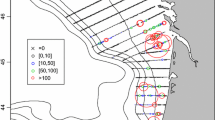Abstract
To compare the results from two overlapping but unpaired synoptic surveys, a method using a geographic information system is proposed. The new method uses a GIS to create (i) minimum convex polygons (MCP) enclosing each set of survey data and (ii) Voronoi tesselations assigning area weights to each datum. The pairs of MCP and Voronoi maps are overlaid to produce a mosaic of polygons each with one datum assigned from each survey. The differences between the pairs weighted by the polygon areas provides the basis for statistical testing. Area-weighted means and variances of paired differences are computed and a z-statistic measures the significance of differences for the whole intersection area. A cross-product autocorrelation statistic provides an assessment of the spatial distribution of differences. Alternate, conventional methods are compared with the new method: analysis of variance (ANOVA), analysis of covariance (ANCOVA), and contour overlays. The four methods were applied to the comparison of two macrobenthic surveys conducted in Lake Erie. Measures for five different taxa were examined. The ANOVA and ANCOVA methods found many significant differences between surveys. Both methods were judged inappropriate as sampling data are not expected to be drawn from normally-distributed populations in spatial surveys. Differences between surveys were detected but were difficult to assess using contour overlays. The new method only found a significant difference in one taxon, an expected difference as members of that taxon were absent from most sites in one survey.
Similar content being viewed by others
References
Burrough, P. A.: 1986, Principles of Geographical Information Systems for Land Resources Assessment, Oxford University Press, New York, 193 pp.
Carr, J. F. and Hiltunen, J. K.: 1965, ‘Changes in the Bottom Fauna of Western Lake Erie from 1930 to 1961’, Limnol. Oceanogr. 10(4), 551–569.
Dermott, R. M.: 1994, ‘Benthic Invertebrate Fauna of Lake Erie 1979: Distribution, Abundance and Biomass’, Can. Tech. Rpt. Fish. Aquat. Sci. 2018, 82.
Griffiths, R.: 1993, ‘Effects of Zebra Mussels (Driessena polymorpha) on the Benthic Fauna of Lake St. Clair’, in Nalepa and Schoesser (eds.), Zebra Mussels: Biology, Impacts, and Control, Lewis Publishers, Boca Raton, Florida, pp. 415–437.
Hubert, L. J., Golledge, R. G. and Costanza, C. M.: 1981, ‘Generalized Procedures for Evaluating Spatial Autocorrelation’, Geogr. Anal. 13(3), 224–233.
Mantel, N.: 1967, ‘The Detection of Disease Clustering and a Generalized Regression Approach’, Cancer Research 27, 209–220.
Monserud, R. A. and Leemans, R.: 1992, ‘Comparing Global Vegetation Maps with the Kappa Statistics’, Ecol. Modelling 62, 275–293.
Snedecor, G. W. and Cochran, W. G.: 1967, Statistical Methods. 6th edn, Iowa State University Press, Ames, Iowa, 593 pp.
Titus, K., Mosher, J. A. and Williams, B. K.: 1984, ‘Chance-corrected Classification For Use in Discriminant Analysis: Ecological Applications’, Amer. Midl. Nat. 111(1), 1–7.
Watson, D. F.: 1992, Contouring: A Guide to the Analysis and Display of Data, Elsevier Science, New York, 321 pp.
Author information
Authors and Affiliations
Rights and permissions
About this article
Cite this article
Minns, C.K., Bakelaar, C.N., Moore, J.E. et al. Measuring differences between overlapping but unpaired spatial surveys using a geographic information system. Environ Monit Assess 43, 237–253 (1996). https://doi.org/10.1007/BF00394452
Issue Date:
DOI: https://doi.org/10.1007/BF00394452




